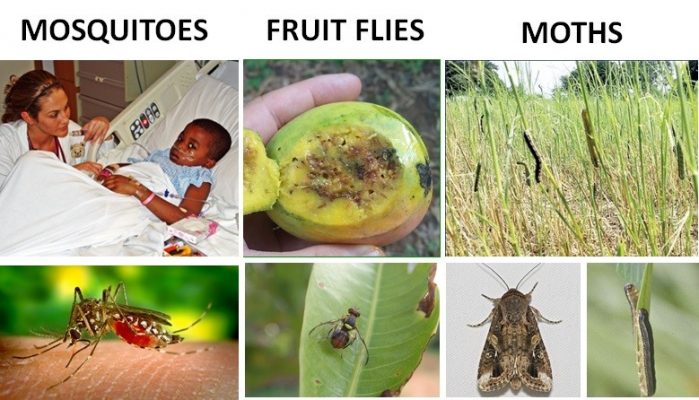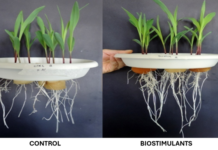(Please note, the article is representing global problems but refers to Africa as a Case Study)Typical to agrarian economies, the African economy is heavily dependent on agriculture. One may wonder; “with over 50% of its population involved in agriculture, why the agricultural economic results are so low?” In a previous article, I had already addressed the fundamental reasons that cerate’s the agricultural pest control difficulties in Africa (see “Does Pest Control Success Has To do With Where You Live?“). In this article, I wish to look deeper into three groups of pests that hurt the African economy the most, by harming the public health, crippling the ability to produce food, and making almost impossible the export of fresh fruit/vegetables. Each pest belonging to the mega-pest compendium has a negative impact on the economy. Now, just imagine what happened in places affected, simultaneously, by all three groups! The Three Mega-Pest Groups MOSQUITOES (e.g., Anopheles, Aedes aegypti) – due to mosquito-borne diseases. In 2017 there were an estimated 219 million cases of Malaria, and 430000 death, from which 93% were in Africa. Resulting in a significant health burden and economic damage. Main problem: health and negative economic impact. MOTHS (e.g., Fall Armyworm, Tuta absoluta) – cause significant (10 to 100 percent) yield loss of both; cash crops and staple crops. Main problem: a shortage of food availability causing necessity to import food and negative economic impact. FRUIT FLIES (e.g., Bactrocera dorsalis, Ceratitis cosyra, B. cucurbitae) – cause 50% yield loss to hundreds of crops (fruits and vegetables). In addition, such high-level infestation, usually, cause fresh produce export ban. Until recently (i.e., the development of Biofeed FreeDome) there was no effective solution. Main problem; – little export, and negative economic impact. Note that the above situation is while using intensive spray regime and despite a massive financial investment over the decades. For example, in 2017 alone, total funding only for malaria control and elimination reached an estimated US$ 3.1 billion (source: WHO). The Combined Effect “Bottom Line” As can be foreseen, the result of the joint damage of these pests is disastrous; The mosquitoes – have a continuous negative impact on health, especially in rural areas, thus weakening farmers’ ability to work, produce to earn a living. Hence, has a negative influence on the economy. Moths damage crops intended for supplying the basic needs of the local diet and fruit flies harm both the diet and the country’s ability to export and bring in foreign currency. As a result, Africa needs to import basic foods, in addition to fruits and vegetables that otherwise grow well in Africa but now infested due to insufficient/improper crop protection. If this is not enough, then under such conditions: (1) no one is ready to invest in African agriculture, and (2) growers, who cannot make their living, are deserting the farms and migrating to cities where they hope to get some job. In the absence of investments, agriculture struggles to survive and cannot move forward. And again, without progress, there is no investment and without investment, there is no export. On top of the above, we should also add the bad feelings and the self-image damage to African farmers, as well as the negative international image of which they receive, although not their fault. The Connecting Thread Let us see if these pests do have something in common. It turns out that if we look at their life characteristics we find that they share some distinctive ones. 1. High fecundity. 2. Small body size. 3. Early maturity onset. 4. Short generation time. 5. Multivoltine – has several generations per year. 6. Ability to disperse offspring widely to long distances. 7. Polyphagous – the ability to feed on various kinds of hosts/food. What Makes These Pests So Problematic? A combination of favorable weather in the tropics, suitable for growing many generations a year, with the availability of inappropriate tools for effective pest control, create a catastrophic result. The easier way to explain is by using the example of fruit fly control, which I am familiar from the time I was a fruit grower, and later from working with many farmers around the world. Let us use Israel and Ghana fruit growers as a case study. Both rely heavily on insecticide sprays, although being aware of its negative environmental and health effects. In Israel, just like in other temperate countries (Europe, USA, etc.) farmers start spraying in the spring, 2 to 5 months before harvest. Spraying is taking place once a week during the summer (the dry season). During the autumn temperature drops and so is the fly population. The outcome is that there is even less need to spray the autumn and winter varieties and crops (e.g., citrus). Furthermore, during rainy cold weeks, there is no need to spray at all. Fruit infestation by fruit flies is 1% to 5% during the warm months of the year, and much lower during the cold months. Note that in recent years many Israeli farmers exchanged the use of fruit fly spraying with non-spraying techniques, such as Biofeed FreeDome. In Ghana, like other tropical countries, it is quite different. Farmers also start spraying 2 to 5 months before the season (in addition to weekly sanitation and use of traps). They spray once a week. However, in Ghana, the fruiting season coincides with the rainy season, which is also warm. The rain washes off the spray/chemicals. As a result, farmers need to spray again after every rain. In some cases, it means spraying every day. But what happens when you spray in the morning, and as you finish it rains again? Will you spray again? It is impractical and extremely expensive when you have a big farm. Critical notes: (2) Be aware that in the tropics there is no ‘cold season’, which means that fruit flies can thrive the whole year-round. As a result fruit infestation is normally 30% to 90%. So you see, sprays can be effective when used during the (short and dry) summer season of the temperate zone. At the same time, the same sprays may be useless in the tropics. Sprays work the best in an environment of cold winters (no insect development take place), and dry, short, summer (fewer generations and sprays remains longest on the plant). This is just one example of why crop protection tools that work well in Europe may not work as well in Africa. That example helps us to understand that African farmers are using improper crop protection tools, and therefore are defenseless. The outcome is catastrophic to the continent. The Obstacles Africa’s pests control problem consists of several fundamental unsolved issues: 1. The pests – we are not talking about one or two pests, but rather dealing with a general failure that includes at least three groups of pests. Each group consists of tens/hundreds of species. 2. The ‘tools’ (solutions) – currently available solutions’ such as GMOs, SIT, and in particular chemical sprays, do not provide an adequate answer to the pest control problem of Africa. 3. Fundamental reasons drive the low pest-control success rate in Africa versus the West. For example, three of the mega-pests causes annual damage on the scale of billions USD: Anopheles spp. that transmit malaria, Fall Armyworm (Spodoptera frugiperda) that consumes many field crops, including maize, and Bactrocera dorsalis that damages fruit/vegetable and hence prevent export. However, despite plenty of researches, projects, and control campaigns (in the case of mosquitoes for over 100 years with an annual investment of several billion USD), no effective solution is in sight. Furthermore, there seems to be no theory or model to follow to success. If we wish to solve the issue of pest control in Africa, and other places, we must develop ways to do it faster and more cost-effective (unlike today; where if lucky, a new solution takes only 30 years and $ 300 million to develop). “Houston, We Have A Problem” There are two options, two approaches, for troubleshooting: * Through trial and error. * Using theories and models (already field-proven). By the end of the day, the second way, i.e. models, though more expensive and slower at first, promises better, faster and more cost-effective results per solution. Finally, while we have a roadmap for solving the pest control problems of Africa; we need a model, as a matter of fact, at least two models: Model 1 – for gaining a better understanding of the mega-pests. Model 2 – for ‘translating’ information from Model 1 into a working solution. In the next article, I will describe the above models, together with one more model, which we cannot do without. |









